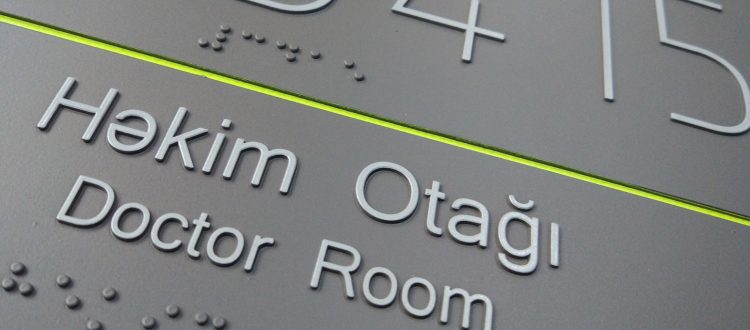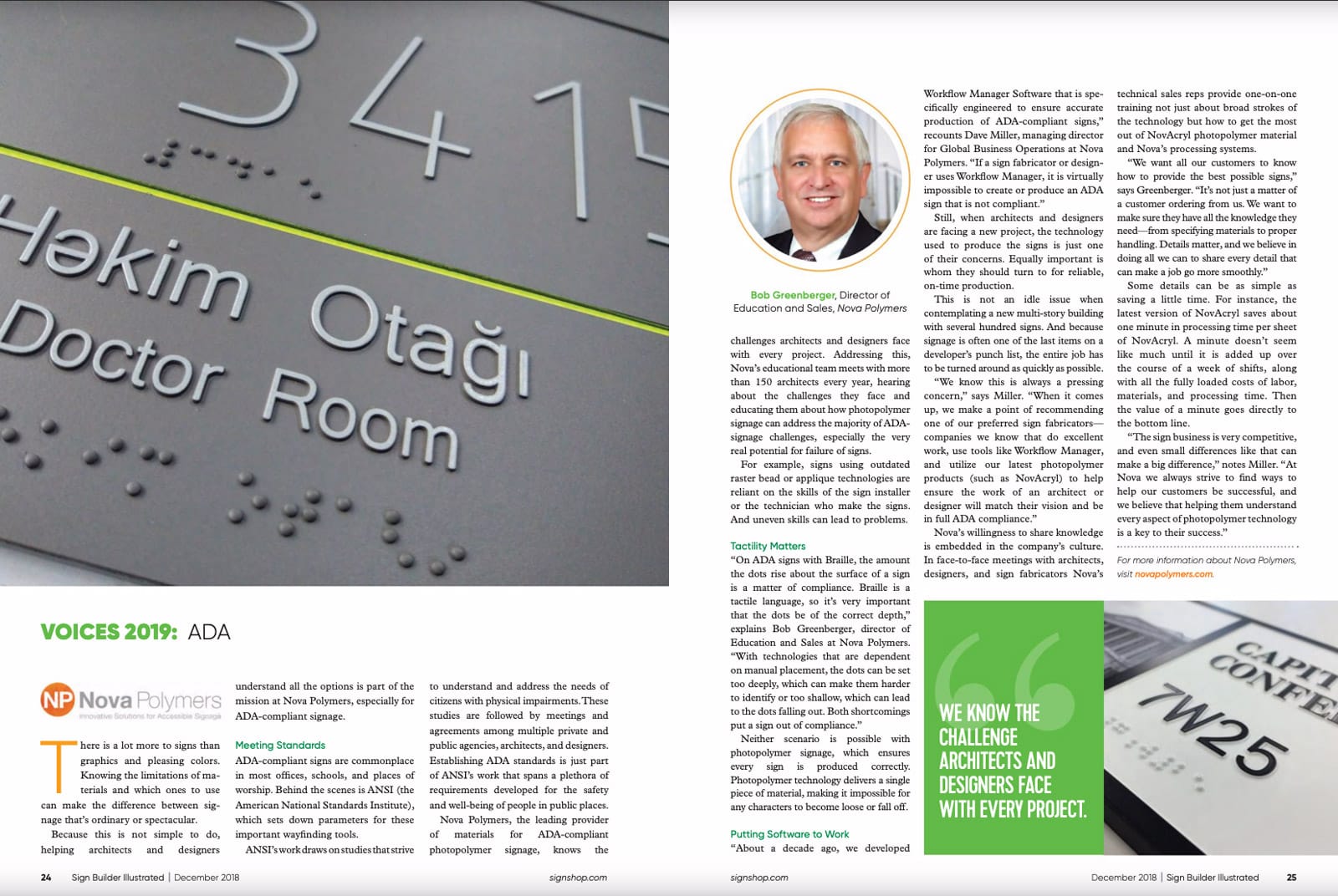Voices 2019 – ADA
This article originally appeared in the December 2018 edition of Sign Builder International, pages 24 and 25.
There is a lot more to signs than graphics and pleasing colors. Knowing the limitations of materials and which ones to use can make the difference between signage that’s ordinary or spectacular.
Because this is not simple to do, helping architects and designers understand all the options is part of the mission at Nova Polymers, especially for ADA-compliant signage.
Meeting Standards
ADA-compliant signs are commonplace in most offices, schools, and places of worship. Behind the scenes is ANSI (the American National Standards Institute), which sets down parameters for these important wayfinding tools.
ANSI’s word draws on studies that strive to understand and address the needs of citizens with physical impairments. These studies are followed by meetings and agreements among multiple private and public agencies, architects, and designers. Establishing ADA standards is just part of ANSI’s work that spans a plethora of requirements developed for the safety and well-being of people in public places.
Nova Polymers, the leading provider of materials for ADA-compliant photopolymer signage knows the challenges architects and designers face with every project. Addressing this, Nova’s educational team meets with more than 150 architects every year, hearing about the challenges they face and educating them about how photopolymer signage can address the majority of ADA-signage challenges, especially the very real potential for failure of signs.
For example, signs using outdated raster bead or appliqué technologies are reliant on the skills of the sign installer or the technician who made the signs. And uneven skills can lead to problems.
Tactility Matters
“On ADA signs with Braille, the amount the dots rise about the surface of a sign is a matter of compliance. Braille is a tactile language, so it’s very important that the dots be of the correct depth” explains Bob Greenberger, director of Education and Sales at Nova Polymers. “With technologies that are dependent on manual placement, the dots can be set too deeply, which can make them harder to identify or too shallow, which can lead to the dots falling out. Both shortcomings put a sign out of compliance.”
Neither scenario is possible with photopolymer signage, which ensures every sign is produced correctly. Photopolymer technology delivers a single piece of material, making it impossible for any characters to become loose or fall off.
Putting Software to Work
“About a decade ago, we developed Workflow Manager Software that is specifically engineered to ensure accurate production of ADA-compliant sign, ” recounts Dave Miller, Managing Director for Global Business Operations at Nova Polymers. “If a sign fabricator or designer uses Workflow Manager, it is virtually impossible to create or produce an ADA sign that is not compliant.”
Still, when architects and designers are facing a new project the technology used to produce the signs is just one of their concerns. Equally important is whom they should turn to for reliable, on-time production.
This is not an idle issue contemplating a new multi-story building with several hundred signs. And because signage is often one of the last items on a developer’s punch list, the entire job has to be turned around as quickly as possible.
“We know this is always a pressing concern” says Miller. “When it comes up, we make a point of recommending one of our preferred sign fabricators -companies we know that do excellent work, use tools like Workflow Manager, and utilize our latest photopolymer products (such as NovAcryl) to help ensure the work of an architect or designer will match their vision and be in full ADA compliance.”
Nova’s willingness to share knowledge is embedded in the company’s culture. In face-to-face meetings with architects, designers and sign fabricators, Nova’s technical sales reps provide one-on-one training not just about broad strokes of the technology but how to get the most out of NovAcryl photopolymer material and Nova’s processing systems.
“We want all our customers to know how to provide the best possible signs” says Greenberger. “It’s not just a matter of a customer ordering from us. We want to make sure they have all the knowledge they need -from specifying materials to proper handling. Details matter, and we believe in doing all we can to share every detail that can make a job go more smoothly.”
Some details can be as simple as saving a little time. For instance, the latest version of NovAcryl saves about one minute in processing time per sheet of NovAcryl. A minute doesn’t seem like much until it is added up over the course of a week of shifts, along with all the fully loaded costs of labor, materials, and processing time. Then the value of a minute goes directly to the bottom line.
“The sign business is very competitive, and even small differences like that can make a big difference” notes Miller. “At Nova, we always strive to find ways to help our customers be successful, and we believe that helping them understand every aspect of photopolymer technology is a key to their success.”


